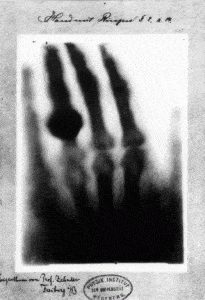
Source: wikipedia.org License: Public Domain
X-rays were discovered on November 8, 1895, by German physics professor Wilhelm Conrad Röntgen at the University of Würtzburg in Germany. He studied electric discharges in glass tubes filled with various gases at very low pressures. In these experiments, Röntgen had covered the tube with some black paper and hand darkened the room. He then discovered that a piece of paper painted with a fluorescent dye would glow when he turned on the high voltage between the electrodes in the tube at some distance from the tube. He realized that he had produced a previously unknown “invisible light,” or ray, that was being emitted from the tube and a ray capable of passing through the heavy paper covering the tube. Röntgen referred to the radiation as “X” to indicate that it was an unknown type of radiation.
Realizing the importance of his discovery, Röntgen focused all his attention on studying this new radiation that had the unusual property of passing through black paper. Through additional experiments, he also found that the new ray would pass through most substances casting shadows on solid objects such as blocks of wood, books, and even his hand. He found that X-rays propagate in straight lines from which they are deflected neither by electric nor magnetic fields. The first x-ray image was a picture of his wife’s hand on a photographic plate formed due to X-rays. His discovery spread quickly throughout the world, and Wilhelm Conrad Röntgen received the first Nobel Prize in Physics for his discovery.